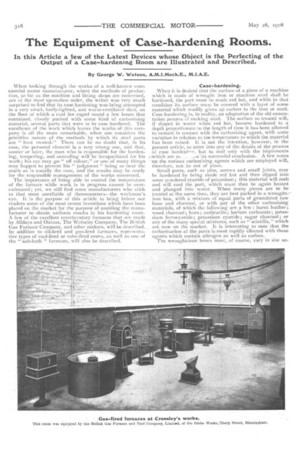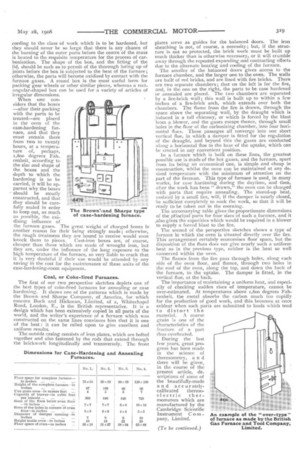The Equipment of Case hardening Rooms.
Page 4

Page 5

If you've noticed an error in this article please click here to report it so we can fix it.
In this Article a few of the Latest Devices whose Object is the Perfecting of the Output of a Case-hardening Room are Illustrated and Described.
By George W. Watson, A.M.I.Mech.E., M.I.A.E.
When looking through the works of a well-known commercial motor manufacturer, where the methods of production, so far as the machine and fitting shops are concerned, are of the most up-to-date order, the writer was very much surprised to find that its case hardening was being attempted in a very small, badly-lighted, and worse-ventilated shed, on the floor of which a coal fire raged round a few boxes that contained, closely packed with some kind of carbonising material, several parts that were to be case hardened. The excellence of the work which leaves the works of this company is all the more remarkable, when one considers the primitive nature of the methods by which its steel parts are " heat treated." There can he no doubt that, in its case, the personal element is a very strong one, and lhat, sooner or later, the man who is responsible for the hardening, tempering, and annealing will be incapacitated for his work ; his eye may go " off colour," or one of many things may happen to prevent his " judgment " being so near the mark as is usually the case, and the results may be costly for the responsible management of the works concerned.
The importance of being able to control the temperature of the furnace while work is in progress cannot be overestimated; yet, we still find some manufacturers who stick to that most unreliable of thermometers—the workman's eye. It is the purpose of this article to bring before our readers some of the most recent inventions which have been placed on the market for the purpose of enabling the manufacturer to obtain uniform results in his hardening room. A few of the excellent reverberatory furnaces that are made by Alldays and Onions, The Wolseley Company, The British Gas Furnace Company, and other makers, will be described. In addition to oil-fired and gas-fired furnaces, representative types of coal-fired or coke-fired ovens, as well as one of the " salt-bath " furnaces, will also be described.
Case-hardening.
When it is desired that the surface of a piece of a machine which is made of wrought iron or machine steel shall be hardened, the part must be made red hot, and while in that condition its surface must be covered with a layer of some material which readily gives. up carbon to the iron or steel. Case hardening is, in reality, an adaptation of the old cementation process of making steel. The surface so treated will, if dipped in water while red hot, become hardened to a depth proportionate to the length of time it has been allowed to remain in contact with the carbonising agent, with some variation in relation to the temperature to which the material has been raised. It is not the intention, however,in the present article, to enter into any of the details of the process of case hardenir■cr, but to deal only with the implements which are nt. ...or=its successful conclusion. A few notes on the various carbonising agents which are employed will, therefore, not be out of place.
Small parts, such as pins, screws and small joints, may be hardened by being made red hot and then dipped into some powdered cyanide of potassium ; this material will melt and will cool the part, which must then be again heated and plunged into water. When many pieces are to be treated at the same time, they are best packed in a wroughtiron box, with a mixture of equal parts of granulated raw bone and charcoal, or with any of the other carbonising materials, of which the following are a few : burnt leather; wood charcoal ; horn; anthracite; barium carbonate; potassium ferrocyanide; potassium cyanide ; sugar charcoal; or any of the many special mixtures, such as " scintilla," which are now on the market. It is interesting to note that the carbonisation of the parts is most rapidly effected with those agents which contain nitrogen as well as carbon. The wrought-iron boxes must, of course, vary in size ac cording to the class of work which is to be hardened, but they should never be so large that there is any chance of the burning of the outer parts before the centre of the mass is heated to the requisite temperature for the process of carbonisation. The shape of the box, and the fitting of the lid, should be such as to permit of the thorough luting up of joints before the box is subjected to the heat of the furnace; otherwise, the parts will become oxidised by contact with the furnace gases. A round box is the most useful form for packing gear wheels or other similar pieces, whereas a rectangular-shaped box can be used for a variety of articles of irregular dimensions.
When one considers that the boxes —after their.packing with the parts to be treated—are placed in the oven of the case-hardening furnace, and that they must remain there from two to twenty hours, at a temperature of, perhaps, 1,800 degrees Fah_ renheit, according to the size and shape of the boxes and the depth to which the hardening is to be carried, it will be apparent why the boxes should be stoutly constructed, and that they should be carefully sealed in order to keep out, as much as possible, the oxidising influence of the furnace gases. The great weight of charged boxes is another reason for their being strongly made ; otherwise, the rough treatment they are bound to receive would soon knock them to pieces. Cast-iron boxes are, of course, cheaper than those which are made of wrought iron, but they are, under the influence of the long exposure to the high temperature of the furnace, so very liable to crack that it is very doubtful if their use would be attended by any saving in the cost for the maintenance of these units of the case-hardening-room equipment. The Brown"rand Sharpe type of case-hardening furnace.
Coal, or Coke-fired Furnaces.
The first of our two perspective sketches depicts one of the best types of coke-fired furnaces for annealing or case hardening. It shows one of the patterns which is made by the Brown and Sharpe Company, of America, for which concern Buck and Hickman, Limited, of 2, Whitechapel Road, London, E., is the British representative. It is a design which has been extensively copied in all parts of the world, and the writer's experience of a furnace which was constructed on the same lines convinces him that it is one of the best : it can be relied upon to give excellent and uniform results.
The outside casing consists of iron plates, which are bolted together and also fastened by the rods that extend through the brickwork longitudinally and transversely. The front plates serve as guides for the balanced doors. The iron sheathing is not, of course, a necessity; but, if the structure is not so protected, the brick work must be built up much thicker than is otherwise necessary, or it will crumble away through the repeated expanding and contracting effects due to the alternate heating and cooling of the furnace.
The smaller of the balanced doors gives access to the furnace chamber, and the larger one to the oven. The walls are built of red bricks, and are lined with fire bricks. There are two separate chambers.; that on the left is for the fire, and, in the one on the right, the parts to be case hardened or annealed are placed. The two chambers are separated by a fire-brick wall ; this wall is built up to within a few inches of a fire-brick arch, which extends over both the chambers. The flame from the fire is drawn, through the space above the separating wall, by the draught which is .induced in a tall chimney, or which is forced by the blast from a blower, and the gases escape thence, through small holes in the floor of the carbonising chamber, into four horizontal flues. These passages all converge into one short vertical flue, in which a damper is fitted for the regulation of the draught, and beyond this the gases are conducted along a horizontal flue to the base of the uptake, which can be erected in any convenient position.
In a furnace which is built on these lines, the greatest possible use is made of the hot gases, and the furnace, apart from its being an economical one, is simple and cheap in construction, whilst the oven can be maintained at any desired temperature with the minimum of attention on the part of the fireman. This type of furnace is used, in many works, for case hardening during the daytime, and then, after the work has been " drawn," the oven can be charged with parts that require annealing. The stored-up heat, assisted by a small fire, will, if the damper is nearly closed, be sufficient completely to soak the work, so that it will be ready to be taken out in the morning.
The accomanying table gives the proportionate dimensions of the pkincipal parts for four sizes of such a furnace, and it also gives the capacities which would be required in a blower to supply a forced blast to the fire.
The second of the perspective sketches shows a type of furnace in which the oven is situated directly over the fire. This arrangement certainly economises floor space, but the disposition of the flues does not give nearly such a uniform heat as in the previous type, neither is the heat so well conserved within the 'oven.
The flames from the fire pass through holes, along each side of the oven floor, and thence, through two holes in the roof of the oven, along the top, and down the back of the furnace, to the uptake. The damper is fitted, in the vertical flue, at the back.
The importance of maintaining a uniform heat, and especially of checking sudden rises of temperature, cannot be over-estimated. At temperatures above 1,600 degrees Fah renheit, the metal absorbs the carbon much too rapidly for the production of good work, and this becomes at once evident when such parts are submitted to loads which tend to distort the material. A coarse grain is one of the characteristics of the fracture of a part thus overheated.
During the last few years, great pro gress has been made in the science of thermometry, a n d there will be given, in the course of the present article, de scriptions of some of the beautifully-made and accurately calibrated thermo electric thermometers which are manufactured by the Cambridge Scientific Instrument Corn pany, Limited.




















